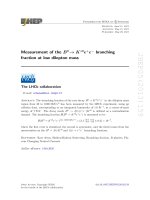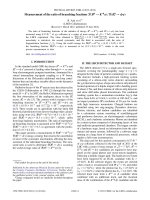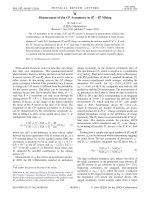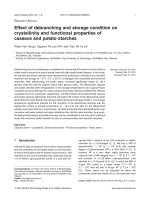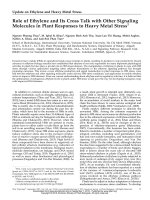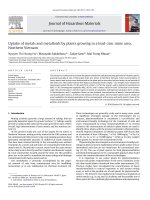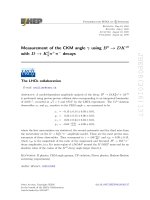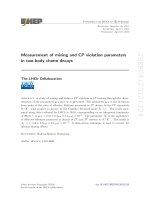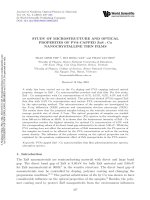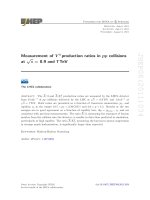DSpace at VNU: Measurement of mixing and CP violation parameters in two-body charm decays
Bạn đang xem bản rút gọn của tài liệu. Xem và tải ngay bản đầy đủ của tài liệu tại đây (595.07 KB, 21 trang )
Published for SISSA by
Springer
Received: December 20, 2011
Accepted: April 3, 2012
Published: April 27, 2012
The LHCb Collaboration
Abstract: A study of mixing and indirect CP violation in D0 mesons through the determination of the parameters yCP and AΓ is presented. The parameter yCP is the deviation
from unity of the ratio of effective lifetimes measured in D0 decays to the CP eigenstate
K + K − with respect to decays to the Cabibbo favoured mode K − π + . The result measured using data collected by LHCb in 2010, corresponding to an integrated luminosity
of 29 pb−1 , is yCP = (5.5 ± 6.3stat ± 4.1syst ) × 10−3 . The parameter AΓ is the asymmetry
0
of effective lifetimes measured in decays of D0 and D mesons to K + K − . The result is
AΓ = (−5.9 ± 5.9stat ± 2.1syst ) × 10−3 . A data-driven technique is used to correct for
lifetime-biasing effects.
Keywords: Hadron-Hadron Scattering
ArXiv ePrint: 1112.4698
Open Access, Copyright CERN,
for the benefit of the LHCb collaboration
doi:10.1007/JHEP04(2012)129
JHEP04(2012)129
Measurement of mixing and CP violation parameters
in two-body charm decays
Contents
1
2 Data selection
2.1 Trigger selection
2.2 Offline selection
3
3
4
3 Determination of decay-time acceptance effects
4
4 Fitting method
6
5 Cross-checks and systematic uncertainties
5.1 Evaluation of systematic uncertainties
5.2 Summary of systematic uncertainties
9
10
11
6 Results and conclusion
12
The LHCb collaboration
16
1
Introduction
Mixing of neutral D0 mesons has only recently been established [1–3] and first evidence
for CP violation in the charm sector has just been observed by LHCb [4]. In this work the
mixing and CP violation parameters yCP and AΓ in the decays of neutral D0 mesons into
two charged hadrons are studied. Both quantities are measured here for the first time at
a hadron collider. The observable yCP is the deviation from unity of the ratio of effective
lifetimes in the decay modes D0 → K − π + and D0 → K − K +
yCP ≡
τ (D0 → K − π + )
− 1,
τ (D0 → K − K + )
(1.1)
where the effective lifetime is defined as the value measured using a single exponential
model. All decays implicitly include their charge conjugate modes, unless explicitly stated
otherwise. Similarly, AΓ is given by the asymmetry of effective lifetimes as
AΓ ≡
τ (D0 → K + K − ) − τ (D0 → K + K − )
.
τ (D0 → K + K − ) + τ (D0 → K + K − )
(1.2)
The neutral D0 mass eigenstates |D1,2 with masses m1,2 and widths Γ1,2 can be
expressed as linear combinations of the flavour eigenstates as |D1,2 = p|D0 ± q|D0 with
complex coefficients p and q satisfying |p|2 + |q|2 = 1. The average mass and width are
defined as m ≡ (m1 + m2 )/2 and Γ ≡ (Γ1 + Γ2 )/2; the mass and width difference are
–1–
JHEP04(2012)129
1 Introduction
used to define the mixing parameters x ≡ (m2 − m1 )/Γ and y ≡ (Γ2 − Γ1 )/(2Γ). The
phase convention is chosen such that CP|D0 = −|D0 and CP|D0 = −|D0 which leads,
in the case of no CP violation (p = q), to |D1 being the CP odd and |D2 the CP even
eigenstate, respectively.
The parameter
q A¯f
q A¯f iφ
λf =
= −ηCP
e ,
(1.3)
pAf
p Af
yCP ≈
1
1
1 − Am 2 y cos φ − Am x sin φ.
8
2
(1.4)
In the limit of no CP violation yCP is equal to y and hence becomes a pure mixing parameter. However, once precise measurements of y and yCP are available, any difference
between y and yCP would be a sign of CP violation.
Previous measurements of yCP have been performed by BaBar and Belle. The results
are yCP = (11.6 ± 2.2 ± 1.8) × 10−3 [8] for BaBar and yCP = (13.1 ± 3.2 ± 2.5) × 10−3 [2]
for Belle. They are consistent with the world average of y = (7.5 ± 1.2) × 10−3 [5].
The study of the lifetime asymmetry of D0 and D0 mesons decaying into the singly
Cabibbo-suppressed final state K + K − can reveal indirect CP violation in the charm sector.
The measurement can be expressed in terms of the quantity AΓ . Using the same expansion
as for yCP leads to
AΓ ≈
≈
1
1
(Am + Ad )y cos φ − x sin φ
2
1 + yCP
1
(Am + Ad )y cos φ − x sin φ.
2
(1.5)
Despite this measurement being described in most literature as a determination of indirect
CP violation by neglecting the term proportional to Ad , it is apparent that direct CP
violation at the level of 10−2 can have a contribution to AΓ at the level of 10−4 . Therefore precise measurements of both time-dependent and time-integrated asymmetries are
necessary to reveal the nature of CP violating effects in the D0 system.
The measurement of AΓ requires tagging the flavour of the D0 at production, which will
be discussed in the following section. Previous measurements of AΓ were performed by Belle
and BaBar leading to AΓ = (0.1 ± 3.0 ± 1.5) × 10−3 [2] and AΓ = (2.6 ± 3.6 ± 0.8) × 10−3 [9],
respectively. They are consistent with zero, hence showing no indication of CP violation.
–2–
JHEP04(2012)129
contains the amplitude Af (A¯f ) of D0 (D0 ) decays to the CP eigenstate f with eigenvalue
ηCP . The mixing parameters x and y are known to be at the level of 10−2 while both
the phase and the deviation of the magnitude from unity of λf are experimentally only
constrained to about 0.2 [5]. The direct CP violation, i.e. the difference in the rates of
D0 and D0 decays, is constrained to the level of 10−2 and has recently been measured by
LHCb [4]. Introducing |q/p|±2 ≈ 1 ± Am and |A¯f /Af |±2 ≈ 1 ± Ad , with the assumption
that Am and Ad are small, and neglecting terms below 10−4 according to the experimental
constraints, one obtains according to [6, 7]
2
Data selection
2.1
Trigger selection
The LHCb trigger consists of hardware and software (HLT) stages. The hardware trigger
is responsible for reducing the LHC pp interaction rate from O(10) MHz to the rate at
which the LHCb subdetectors can be read out, nominally 1 MHz. It selects events based
on the transverse momentum of track segments in the muon stations, the transverse energy
of clusters in the calorimeters, and overall event multiplicity.
The HLT further reduced the event rate to about 2 kHz in 2010, at which the data was
stored for offline processing. The HLT runs the same software for the track reconstruction
and event selection as is used offline and has access to the full event information.
The first part of the HLT is based on the reconstruction of tracks and primary interaction vertices in the VELO. Heavy flavour decays are identified by their large lifetimes,
which cause their daughter tracks to be displaced from the primary interaction. The trigger
first selects VELO tracks whose distance of closest approach to any primary interaction,
known as the impact parameter (IP), exceeds 110 µm. In addition the tracks are required
to have at least ten hits in the VELO to reduce further the accepted rate of events. This cut
limits the fiducial volume for D0 decays and therefore rejects events where the D0 candidate has a large transverse component of the distance of flight, causing an upper bound on
the decay-time acceptance. The term decay-time acceptance will be used throughout this
paper to refer to the selection efficiency as a function of the D0 decay time. Selected tracks
are then used to define a region of interest in the tracking stations after the dipole magnet,
whose size is defined by an assumed minimum track momentum of 8 GeV/c; hits inside
these search regions are used to form tracks traversing the full tracking system. Tracks
passing this selection are fitted, yielding a full covariance matrix, and a final selection is
made based on the track-fit quality and the track χ2 (IP). The χ2 (IP) is a measure of the
consistency with the hypothesis that the IP is equal to zero. At least one good track is
required for the event to be accepted. The requirements on both the track IP and on the
χ2 (IP) reduce the number of D0 candidates with a short decay time.
–3–
JHEP04(2012)129
LHCb is a precision heavy flavour experiment which exploits the abundance of charm particles produced in collisions at the Large Hadron Collider (LHC). The LHCb detector [10]
is a single arm spectrometer at the LHC with a pseudorapidity acceptance of 2 < η < 5
for charged particles. High precision measurements of flight distances are provided by the
Vertex Locator (VELO), which consists of two halves with a series of semi-circular silicon
microstrip detectors. The VELO measurements, together with momentum information
from forward tracking stations and a 4 Tm dipole magnet, lead to decay-time resolutions
of the order of one tenth of the D0 lifetime. Two Ring-Imaging Cherenkov (RICH) detectors using three different radiators provide excellent pion-kaon separation over the full
momentum range of interest. The detector is completed by hadronic and electromagnetic
calorimeters and muon stations. The measurements presented here are based on a data
√
sample corresponding to an integrated luminosity of 29 pb−1 of pp collisions at s = 7 TeV
recorded during the LHC run in 2010.
In the second part of the HLT, an exclusive selection of D0 candidates is performed
by reconstructing two-track vertices. Further cuts are placed on the χ2 (IP) of the D0
daughters and the displacement significance of the D0 vertex from the primary interaction,
as well as a requirement which limits the collinearity angle between the D0 momentum and
the direction of flight, as defined by the primary and decay vertices. These cuts all affect
the distribution of the decay time of the D0 candidates. Additional cuts are placed on
track and vertex fit quality, and on kinematic quantities such as the transverse momentum
of the D0 candidate, which have no effect on the decay-time distribution.
Offline selection
Given the abundance of charm decays, the selection has been designed to achieve high
purity. It uses similar requirements to those made in the trigger selection, though often
with tighter thresholds. In addition it makes use of the RICH information for separating
kaons and pions. A single kaon is positively identified with an efficiency of on average about
83%, while less than 5% of the pions are wrongly identified as kaons, when taking into
account the momentum distribution of the decay products. A mass window of ±16 MeV/c2
(about ±2σ) is applied to the invariant mass of the two D0 daughter particles using the
appropriate mass hypotheses. After these criteria have been applied there is negligible
remaining cross-feed between the different two-body D0 decay modes.
Flavour tagging of the D0 decays is done by reconstructing the D∗+ → D0 πs+ decay,
where the charge of the slow pion, πs , determines the flavour of the D0 meson at production.
The selection applies loose requirements on the kinematics of the bachelor pion and the
quality of the D∗+ vertex fit. The most powerful variable for selecting the D∗+ decay is the
difference in the reconstructed invariant masses of the D∗+ and the D0 candidates, ∆m.
Candidates are required to have ∆m in the range |∆m − 145.4 MeV/c2 | < 2.0 MeV/c2 .
Events with multiple signal candidates are excluded from the analysis. For tagged D0
decays this causes a reduction of the number of candidates of about 15% due to the high
probability of assigning a random slow pion to form a D∗+ candidate. The numbers of
selected candidates are 286 155 for D0 → K − π + and 39 262 for D0 → K + K − decays.
3
Determination of decay-time acceptance effects
Since absolute lifetime measurements are used to extract yCP and AΓ , it is essential to correct for lifetime-biasing effects. The analysis uses a data-driven approach that calculates,
for each candidate and at every possible decay time, an acceptance value of zero or one
which is related to the trigger decision and offline selection. The method used to determine decay-time acceptance effects is based on the so-called “swimming” algorithm. This
approach was first used at the NA11 spectrometer [11], further developed within DELPHI [12] and CDF [13, 14], studied at LHCb [15, 16], and applied to the measurement of
the Bs0 → K + K − lifetime [17].
Lifetime-biasing effects originate from selection criteria or from efficiencies that depend
on the decay time. The swimming method accounts for selection biases. Efficiency effects
are estimated and, where necessary, corrected for as described at the end of this section.
–4–
JHEP04(2012)129
2.2
ft (t|A) =
1 −t/τ
Θ(t)A(t)
τe
,
∞ 1 −t′ /τ
Θ(t′ )A(t′ )dt′
−∞ τ e
(3.1)
where τ is the average lifetime of the decay, Θ(t) is the Heaviside function, and A(t) is
the decay-time acceptance function for this candidate. If the event-by-event acceptance
function, A(t), consists of pairs of turning points, (tmin,i , tmax,i ), eq. (3.1) leads to
ft (t|A) =
i
1 −t/τ
Θ(t)
τe
,
−t
/τ
max,i
[e
− e−tmin,i /τ ]
(3.2)
with i summing over the pairs of acceptance turning points and assuming that t lies in an
accepted time interval, i.e. tmin,i < t < tmax,i or A(t) = 1, and ft (t|A) = 0 if A(t) = 0.
The swimming method determines the turning points of the per-event acceptance by
moving the primary interaction vertex in steps along the direction of the D0 momentum.
At each step the selection decision is evaluated which yields the value of the acceptance
function corresponding to the decay time of this step. The decay time is calculated using the
distance of the moved primary interaction vertex to the decay vertex. In events containing
multiple primary vertices, all are moved by the same amount in the direction of the D0
momentum. This procedure is executed twice: once for the trigger selection and once
for the offline selection. The two resulting acceptance functions are combined to a single
acceptance function by including only the ranges which have been accepted by both steps.
The novelty in this implementation of the swimming method is the ability to execute
the LHCb trigger, including the reconstruction, in precisely the same configuration used
–5–
JHEP04(2012)129
The swimming method relies on the fact that the selection criteria which can cause a bias
depend on the geometry of the specific decay, while the probability of a decay to occur
with this geometry is independent of the decay time.
The per-event acceptance at any given decay time can be 1 to signify that the event
would have been triggered or selected at that decay time, or 0 to show that it would
have been rejected. The values are 0 or 1 as the overall selection efficiency factorises out.
One example of a requirement that causes a non-trivial decay time acceptance is that
on the minimum value of the impact parameter of the decay product tracks. An impact
parameter is the closest distance of approach of an extrapolated track to the primary
interaction vertex. Such a selection criterion leads to a step in the acceptance as a function
of decay-time as shown in figure 1. The acceptance is, of course, 1 at the measured decay
time of that event, tmeas . However, the location of the step in the function depends on the
geometry of the event and does not depend on tmeas .
Several effects can lead to a more complex shape of the acceptance function than a
single step. A second primary interaction vertex can for example lead to a gap in the
acceptance for the decay-time range, for which the impact parameter of one track with
respect to this second vertex falls below the threshold. Therefore, the general per-event
acceptance function can be described by a series of steps, called “turning points”.
The acceptance function is used in the normalisation of the decay-time probability
density function (PDF). The single-event probability density of measuring a decay at time
t, ignoring measurement errors, is given by
h+
h+
IP2
IP1
h+
IP2
D0
h’−
IP1
IP2
D0
h’−
IP1
D0
accepted?
accepted?
accepted?
1=yes
1=yes
1=yes
0=no
t
0=no
0=no
(b)
tmin tmeas
t
(c)
Figure 1. Evolution of the decay-time acceptance function for a two-body D0 decay. The shaded,
light blue regions show the bands for accepting a track impact parameter. While the impact parameter of the negative track (IP2) is too low in (a) it reaches the accepted range in (b). The actual
measured decay time, tmeas , lies in the accepted region which continues to larger decay times (c).
during data taking. This is made possible by the implementation of all lifetime-biasing
trigger requirements being in software as opposed to hardware.
Studying the decay-time dependence of the acceptance in principle requires moving the
hits produced by the D0 decay products, rather than the primary vertices. Our implementation leads to significant technical simplifications. This ignores the fact that events are no
longer accepted if the mother particle has such a long decay time that one or both tracks
can no longer be reconstructed inside the VELO. This is a very small effect as a D0 meson
has to fly ten to a hundred times its average distance of flight in order to escape detection
in the VELO. Nevertheless, this effect has been estimated based on the knowledge of the
position of the VELO modules and on the number of hits required to form a track. The
limit of the acceptance is determined by swimming the tracks along the D0 momentum
vector. The result is treated as another per event decay-time acceptance and merged with
the acceptance of the trigger and offline selections.
Finally, the track reconstruction efficiency in the trigger is reduced compared to the
offline reconstruction due to the requirements described in section 2. It has been verified,
using a smaller sample acquired without a lifetime biasing selection, that this relative
reconstruction efficiency does not depend on the decay time of the D0 candidate with a
precision of 3 × 10−3 , and therefore introduces no significant additional acceptance effect.
4
Fitting method
The peak in ∆m from true D∗+ decays is parametrised as the sum of three Gaussians; two
of which have a common mean and a third which has a slightly higher mean. The random
πs background PDF is given by
fπs (∆m) =
∆m
a
2
1 − exp(−
∆m − d
)
c
–6–
+ b
∆m
−1
d
∆m ≥ d,
(4.1)
JHEP04(2012)129
(a)
t
tmin
h’−
103
158
LHCb
156
154
102
152
150
148
10
146
144
Entries per 0.13 (MeV/c2)2
∆m (MeV/c2)
160
142
140
1820
1840
1860
1880
1900
1
mD0 (MeV/c2)
Entries / 0.10 MeV/c2
Entries / 0.10 MeV/c2
14000
LHCb
12000
10000
8000
6000
4000
1800
LHCb
1600
1400
1200
1000
800
600
400
2000
0
140
2000
200
145
150
155
160
2
∆m (MeV/c )
0
140
145
150
155
160
∆m (MeV/c2)
Figure 3. ∆m fit projections of (left) D0 → K − π + and (right) D0 → K + K − candidates to which
the full offline selection apart from the cut in ∆m has been applied. Shown are data (points), the
total fit (green, solid) and the background component (blue, dot-dashed).
where a and b define the slope at high values of ∆m, c defines the curvature at low values of
∆m and ∆m = d defines the threshold below which the function is equal to zero. Figure 2
shows the ∆m vs mD0 distribution and figure 3 shows the fit to the mass difference between
the reconstructed invariant masses of D∗+ and D0 candidates, ∆m.
The signal yield is extracted from fits to the reconstructed D0 invariant mass distribution after application of the cut in ∆m. The fit model for the signal peak has been
chosen to be a double Gaussian and background is modelled as a first-order polynomial.
The background level is evaluated to be about 1% for D0 → K − π + decays and about
3% for D0 → K + K − decays. It consists of combinatorial background and partially reconstructed or misidentified D0 decays. If the latter stem from a D∗+ decay they have a
peaking distribution in ∆m similar to signal candidates. The data in the mass sidebands
are insufficient to reliably describe the background shape in other variables, so the background contribution is neglected in the time-dependent fit and a systematic uncertainty is
estimated accordingly. All fits are carried out as unbinned maximum likelihood fits.
–7–
JHEP04(2012)129
Figure 2. ∆m vs mD0 distribution for D0 → K − π + candidates. The contribution of random
slow pions extends around the signal peak in the vertical direction while background is visible as a
horizontal band.
Events inside the signal windows in ∆m and mD0 are used in the lifetime fit, where
mesons produced at the primary vertex (prompt) have to be distinguished from those
originating from b hadron decays (secondary). The combined PDF for this decay-time
dependent fit is factorized as
D0
fIP (χ2 (IPD )|t, A, class) ft (t|A, class) fTP (A|class) P (class).
f (χ2 (IPD ), t, A) =
class
=prompt,
secondary
• the time-dependent PDFs for the ln χ2 (IPD ) values for prompt and secondary D0
mesons;
• the decay-time PDFs for prompt and secondary D0 mesons;
• the PDF for the turning points which define the acceptance A;
• the fractions of prompt and secondary D0 decays among the signal candidates.
The separation of prompt and secondary D0 mesons is done on a statistical basis
using the impact parameter of the D0 candidate with respect to the primary vertex, IPD .
For prompt decays, this is zero up to resolution effects, but can acquire larger values
for secondary decays as the D0 candidate does not in general point back to the primary
vertex. Since an estimate of the vertex resolution is available on an event-by-event basis,
it is advantageous to use the χ2 of the IPD instead of the impact parameter value itself.
The natural logarithm of this quantity, ln(χ2 (IPD )), allows for an easier parametrisation.
Empirically, the sum of two bifurcated Gaussians, i.e. Gaussians with different widths
on each side of the mean, and a third, symmetric Gaussian, all sharing a common peak
position, is found to be a suitable model to describe the ln(χ2 (IPD )) distribution for both
prompt and secondary D0 decays.
For the prompt D0 class the ln(χ2 (IPD )) distribution does not change with D0 decay
time as the true value is zero at all times and the resolution of IPD can be assumed to
be independent of the measured decay time. For secondary D0 decays the decay-time
and ln(χ2 (IPD )) are correlated. The width of the ln(χ2 (IPD )) distribution is found to
be approximately constant in decay time for both prompt and secondary D0 mesons. As
Monte Carlo simulation studies suggest that secondary decays have a larger width in this
variable, a scale factor between the widths for prompt and secondary mesons is introduced.
The mean value of ln(χ2 (IPD )) increases with D0 decay time, which reflects the fact that D0
mesons coming from other long-lived decays do not necessarily point back to the primary
vertex and that they may point further away the further their parent particle flies. The
functional form for this time dependence is based on simulation and all parameters are
determined in the fit to data.
The decay-time PDF, ft (t|A, class) is modelled as a single exponential for the prompt
0
D class and as a convolution of two exponentials for secondary decays. To account for
–8–
JHEP04(2012)129
(4.2)
The four factors on the right-hand side of eq. (4.2), which will be described in detail
below, are:
5
Cross-checks and systematic uncertainties
The method for absolute lifetime measurements described in section 4 comprises three
main parts whose accuracy and potential for biasing the measurement have to be evaluated
in detail:
• the determination of the event-by-event decay-time acceptance;
• the separation of prompt from secondary charm decays;
• the estimation of the decay time distribution of combinatorial background.
Since the contribution of combinatorial background is ignored in the fit, it is important to
evaluate the corresponding systematic uncertainty. Furthermore, several other parameters
are used in the fit whose systematic effects have to be evaluated, e.g. the description of
the decay-time resolution. It is generally expected that the systematic uncertainties in yCP
are similar to or larger than those in AΓ as in yCP two different final states contribute
to the measurement.
Several consistency checks are performed by splitting the dataset into subsets. The stability is tested as a function of run period, D0 momentum and transverse momentum, and
–9–
JHEP04(2012)129
resolution effects, these are convolved with a single Gaussian resolution function. The
parameters of the resolution model are obtained from a fit to the decay time distribution
of prompt J/ψ events. The resulting dilution is equivalent to that of a single Gaussian
with a width of 50 fs [18]. The decay-time probability densities are properly normalized
by integrating their product with the acceptance function A, evaluated by the swimming
method, only over the decay-time intervals for which the event would have been accepted.
Hence, the acceptance turning points are used as boundaries in the integration.
Finally, a PDF for the per-event acceptance function is needed. While the first acceptance turning point, i.e. the one with the smallest decay time, depends on the D0 decay
topology, the others are governed more by the underlying event structure, e.g. the distribution of primary vertices. The primary vertex distribution is independent of whether the
D0 candidate is of prompt or secondary origin. Hence, the PDF can be approximated as
fTP (A|class) ≈ fTP (TP1 |class), where TP1 denotes the position of the first turning point.
The distribution for fTP (TP1 |prompt) is obtained by applying a cut at ln χ2 (IPD ) < 1, thus
selecting a very pure sample of prompt decays. The distribution for fTP (TP1 |secondary) is
obtained from the distribution of TP1 weighted by the probability of each candidate being
of secondary decay origin.
An initial fit is performed using the full ln χ2 (IPD ) distribution and all parameters in
the description of this term are then fixed in the final fit. A cut is then applied requiring ln χ2 (IPD ) < 2 in order to suppress the fractions of both background and secondary
candidates to less than a few percent. The final fit is performed on this reduced sample,
which contains 226 110 D0 → K − π + and 30 481 D0 → K + K − candidates. The effect of
this procedure is estimated in the systematic uncertainty evaluation.
5.1
Evaluation of systematic uncertainties
Particle decay times are measured from the distance between the primary vertex and secondary decay vertex in the VELO. The systematic uncertainty from the distance scale
is determined by considering the potential error on the length scale of the detector from
the mechanical survey, thermal expansion and the current alignment precision. A relative systematic uncertainty of 0.1% is assigned to the measurements of absolute lifetimes,
translating into a relative uncertainty of 0.1% on AΓ and yCP .
The method to evaluate the turning points of the decay-time acceptance functions
described in section 3 uses an iterative approach which estimates the turning points to a
precision of about 1 fs. Two scenarios have been tested: a common bias of all acceptance
turning points and a common length scaling of the turning points, which could originate
from differences in the length scale in the trigger and offline reconstructions. From a
variation of the bias and the scale, a systematic uncertainty of 0.1 × 10−3 on AΓ and yCP
is determined.
The reconstruction acceptance is dominated by the VELO geometry, which is accounted for by the method described in section 3. This leads to a correction of less than
1 fs on the absolute lifetime measurements, i.e. a relative correction of about 0.24%. No
further systematic uncertainty is assigned to AΓ or yCP as the size of this relative correction
is negligible. Additional studies of the reconstruction efficiency as a function of variables
governing the decay geometry did not provide any indication of lifetime biasing effects.
The decay-time resolution is modelled by a single Gaussian. The width of the resolution
function is varied from its nominal value of 0.05 ps between 0.03 ps and 0.07 ps. The range of
variation was chosen to cover possible alignment effects as well as effects from the different
final state used to evaluate the resolution. The result leads to a systematic uncertainty of
0.1 × 10−3 for AΓ and yCP .
The fit range in decay time is restricted by lower and upper limits. The lower limit
is put in place to avoid instabilities in regions with extremely low decay-time acceptances
and very few events. The default cut value is 0.25 ps which is close to the lower end of the
– 10 –
JHEP04(2012)129
primary vertex multiplicity. No significant trend is observed and therefore no systematic
uncertainty assigned.
The fitting procedure is verified using simplified Monte Carlo simulation studies. No
indication of a bias is observed and the statistical uncertainties are estimated accurately.
A further test is carried out using full Monte Carlo simulation to a relative precision of
0.9%. The acceptance effects are corrected using the same method as applied to data. The
generated lifetime is obtained in the fit which implies that the lifetime biasing effects are
properly corrected.
As an additional check, a control measurement is performed using the lifetime asymmetry of D0 and D0 decays to the Cabibbo favoured decay D0 → K − π + . The result is in
agreement with zero and the flavour-averaged D0 lifetime is found to be consistent with
the world average. Detailed results are given in section 6. The fit results for D0 → K + K −
decays were not revealed throughout the development of the method and the study of
systematic uncertainties for the measurements of yCP and AΓ .
5.2
Summary of systematic uncertainties
Table 1 summarises the systematic uncertainties evaluated as described above. The main
systematic uncertainties are due to neglecting the combinatorial background and to the
contribution of secondary-like decays. The total systematic uncertainties for AΓ and yCP ,
obtained by combining all sources in quadrature, are 2.1×10−3 and 4.1×10−3 , respectively.
– 11 –
JHEP04(2012)129
observed range of events. This cut is varied to both 0.2 ps and 0.3 ps. The result leads to
a systematic uncertainty of 0.1 × 10−3 for AΓ and 0.8 × 10−3 for yCP .
The upper limit of the fit range in decay time is put in place to minimise the impact
of long-lived background events. The default cut is put at 6 ps which corresponds to about
15 D0 lifetimes. This cut is varied to 5 ps and 8 ps. The result leads to a systematic
uncertainty of 0.2 × 10−3 for AΓ and yCP .
The description of the contribution from combinatorial background is studied by varying its relative amount in the data sample and repeating the fit. This is done by changing
the ∆m window from the default of ±2 MeV/c2 to ±1 MeV/c2 and ±3 MeV/c2 . The result
leads to a systematic uncertainty of 1.3 × 10−3 for AΓ and 0.8 × 10−3 for yCP .
Events that originate from secondary charm decays are the background with the largest
impact on the fit procedure as they have a very different decay-time distribution compared
to prompt charm decays, but they peak in the invariant mass and ∆m distributions. Also a
fraction of combinatorial background events appear to be secondary-like in their ln χ2 (IPD )
distribution. The cut of ln χ2 (IPD ) < 2 removes a large fraction of secondary-like events.
However, it is important that the remainder is properly modelled and does not bias the
signal lifetime. Varying this cut changes the relative number of secondary-like decays in the
sample and therefore tests the stability of the secondary description in the fit model. The
fraction of secondary-like combinatorial background events is also altered with this test.
The ln χ2 (IPD ) cut is varied from 1.5 which is just above the peak of the prompt distribution
to 3.5 where the probability densities for prompt and secondary decays are about equal.
The result leads to a systematic uncertainty of 1.6 × 10−3 for AΓ and 3.9 × 10−3 for yCP .
The uncertainty is significantly larger for yCP than for AΓ as may be expected from the
difference in the background level in the channels involved in the yCP measurement.
Additional studies were performed to estimate the potential impact of neglecting background events in the fit. A background component was added to a simplified simulation.
The background decay time distribution was generated using extreme values of fits to the
distribution observed in mass sidebands. The average bias on the measurement of yCP was
about 2 × 10−3 . Since this is consistent with the assigned systematic uncertainty, we do
not assign any additional uncertainty.
Furthermore, a background component was added to the D0 decay-time PDF with a
fixed fraction and average lifetime. The fraction of this component, which was assumed
to be secondary-like, was varied. A change in the fit result for yCP of 0 (all background
secondary-like) to 4 × 10−3 (all background prompt-like) was observed. As it is known that
a fraction of the background events are secondary-like, this result is considered consistent
with the simplified simulation results.
Effect
Decay-time acceptance correction
Decay-time resolution
Minimum decay-time cut
Maximum decay-time cut
Combinatorial background
Secondary-like background
Total
AΓ (10−3 )
0.1
0.1
0.1
0.2
1.3
1.6
2.1
yCP (10−3 )
0.1
0.1
0.8
0.2
0.8
3.9
4.1
Entries/0.05
103
LHCb
102
10
1
-10
-5
0
5
10
lnχ2(IP )
Pull
D
4
3
2
1
0
-1
-2
-3
-4
-10
-5
0
5
10
lnχ2(IP )
D
Figure 4. ln χ2 (IPD ) fit projection of D0 → K + K − candidates in logarithmic scale. Shown are
data (points), the total fit (green, solid), the prompt signal (blue, short-dashed), and the secondary
signal (purple, long-dashed). The lower two plot shows the pull distribution which is defined as the
difference of data and model divided by the uncertainty.
6
Results and conclusion
The measurement of yCP is based on absolute lifetime measurements as described in section 4. It uses flavour-tagged events reconstructed in the decay chain D∗+ → D0 π + , with
D0 and D0 decays fitted simultaneously per decay mode. The ln χ2 (IPD ) projection of the
final fit is shown in figure 4.
The result for the lifetime measured in D0 → K − π + decays is τ (D0 ) = 410.2 ± 0.9 fs
where the uncertainty is statistical only. The result for the lifetime is found to be in
agreement with the current world average [19]. Combining with the D0 → K + K − lifetime
measurement, τ (D0 ) = 408.0 ± 2.4stat fs, this leads to the final result for yCP of
yCP = (5.5 ± 6.3stat ± 4.1syst ) × 10−3 .
– 12 –
JHEP04(2012)129
Table 1. Summary of systematic uncertainties.
Entries / 0.05 ps
Entries / 0.05 ps
103
103
LHCb
102
102
10
10
1
1
6
Decay time (ps)
Pull
4
2
4
6
4
3
2
1
0
-1
-2
-3
-4
2
4
2
4
Decay time (ps)
6
Decay time (ps)
6
Decay time (ps)
Figure 5. Proper-time fit projections of (left) D0 → K + K − and (right) D0 → K + K − candidates
after application of the ln χ2 (IPD ) < 2 cut. Shown are data (points), the total fit (green, solid),
the prompt signal (blue, short-dashed), and the secondary signal (purple, long-dashed). The lower
two plot shows the pull distribution which is defined as the difference of data and model divided
by the uncertainty.
The measurement of AΓ is performed based on the same dataset and applying the
same fitting method as used for the extraction of yCP . A control measurement is performed
using decays to the Cabibbo favoured mode D0 → K − π + by forming a lifetime asymmetry
analogous to eq. (1.2). The measured flavour-tagged lifetimes are effective parameters
since the fitted distributions also include mistagged events. For the control measurement
using D0 → K − π + decays this contamination is ignored as it is negligible due to the
=
Cabibbo suppression of the mistagged decays. The result for the asymmetry is AKπ,eff
Γ
(−0.9 ± 2.2stat ) × 10−3 which is consistent with zero, according to expectations.
For the extraction of AΓ , the mistagged decays are taken into account by expressing
the measured effective lifetimes, τ eff , in terms of the flavour-tagged lifetimes, τ (D0 ) and
τ (D0 ), and the mistag rate, ǫ± , where the sign is according to the sign of the tagging pion:
τ eff (D0 ) ≈ (1 − ǫ+ ) τ (D0 ) + ǫ+ τ (D0 )
τ
eff
0
0
0
(D ) ≈ (1 − ǫ− ) τ (D ) + ǫ− τ (D ).
(6.1)
(6.2)
The mistag rates are assumed to be independent of the final state and are extracted from
the favoured D0 → K − π + decays as half the fraction of the random slow pion background
in the signal region of the ∆m distribution. They are found to be about 1.8%. The
systematic uncertainty due to this correction is negligible.
The projection of the decay-time fit to D0 and D0 candidates in D0 → K + K − decays
is shown in figure 5. After applying the mistag correction, the resulting value of AΓ is
AΓ = (−5.9 ± 5.9stat ± 2.1syst ) × 10−3 .
– 13 –
JHEP04(2012)129
Pull
2
4
3
2
1
0
-1
-2
-3
-4
LHCb
Both results on yCP and AΓ are compatible with zero and in agreement with previous
measurements [2, 8, 9]. Future updates are expected to lead to significant improvements
in the sensitivity. The systematic uncertainty is expected to be reduced by an improved
treatment of background events which will be possible for the data taken in 2011.
Acknowledgments
Open Access. This article is distributed under the terms of the Creative Commons
Attribution License which permits any use, distribution and reproduction in any medium,
provided the original author(s) and source are credited.
References
¯ 0 mixing,
[1] BABAR collaboration, B. Aubert et al., Evidence for D0 D
Phys. Rev. Lett. 98 (2007) 211802 [hep-ex/0703020] [INSPIRE].
[2] Belle collaboration, M. Staric et al., Evidence for D0 - 2 mixing,
Phys. Rev. Lett. 98 (2007) 211803 [hep-ex/0703036] [INSPIRE].
¯ 0 mixing parameters in
[3] BELLE collaboration, K. Abe et al., Measurement of D0 − D
0
0 + −
D → KS π π decays, Phys. Rev. Lett. 99 (2007) 131803 [arXiv:0704.1000] [INSPIRE].
[4] LHCb collaboration, R. Aaij et al., Evidence for CP-violation in time-integrated D0 → h− h+
decay rates, Phys. Rev. Lett. 108 (2012) 111602 [arXiv:1112.0938] [INSPIRE].
[5] Heavy Flavor Averaging Group collaboration, D. Asner et al., Averages of b-hadron,
c-hadron and τ -lepton properties, arXiv:1010.1589 [INSPIRE].
[6] S. Bergmann, Y. Grossman, Z. Ligeti, Y. Nir and A.A. Petrov, Lessons from 2 and 2
¯ 0 mixing parameters, Phys. Lett. B 486 (2000) 418
measurements of D0 − D
[hep-ph/0005181] [INSPIRE].
[7] M. Gersabeck, M. Alexander, S. Borghi, V. Gligorov and C. Parkes, On the interplay of
direct and indirect CP-violation in the charm sector, J. Phys. G 39 (2012) 045005
[arXiv:1111.6515] [INSPIRE].
¯ 0 Mixing using the Ratio of
[8] BABAR collaboration, B. Aubert et al., Measurement of D0 -D
Lifetimes for the Decays D0 —¿ K- pi+ and K+ K-, Phys. Rev. D 80 (2009) 071103
[arXiv:0908.0761] [INSPIRE].
– 14 –
JHEP04(2012)129
We express our gratitude to our colleagues in the CERN accelerator departments for the
excellent performance of the LHC. We thank the technical and administrative staff at
CERN and at the LHCb institutes, and acknowledge support from the National Agencies: CAPES, CNPq, FAPERJ and FINEP (Brazil); CERN; NSFC (China); CNRS/IN2P3
(France); BMBF, DFG, HGF and MPG (Germany); SFI (Ireland); INFN (Italy); FOM
and NWO (The Netherlands); SCSR (Poland); ANCS (Romania); MinES of Russia and
Rosatom (Russia); MICINN, XuntaGal and GENCAT (Spain); SNSF and SER (Switzerland); NAS Ukraine (Ukraine); STFC (United Kingdom); NSF (U.S.A.). We also acknowledge the support received from the ERC under FP7 and the Region Auvergne.
¯ 0 mixing using the ratio of
[9] BABAR collaboration, B. Aubert et al., Measurement of D0 - D
lifetimes for the decays D0 → K − π + , K − K + and π − π + , Phys. Rev. D 78 (2008) 011105
[arXiv:0712.2249] [INSPIRE].
[10] LHCb collaboration, J. Alves, A. Augusto et al., The LHCb Detector at the LHC,
2008 JINST 3 S08005 [INSPIRE].
[11] R. Bailey, E. Belau, T. Bohringer, M. Bosman, V. Chabaud, et al., Measurement of the
lifetime of charged and neutral D mesons with high resolution silicon strip detectors,
Z. Phys. C 28 (1985) 357 [INSPIRE].
[13] J. Rademacker, Reduction of statistical power per event due to upper lifetime cuts in lifetime
measurements, Nucl. Instrum. Meth. A 570 (2007) 525 [hep-ex/0502042] [INSPIRE].
[14] CDF collaboration, T. Aaltonen et al., Measurement of the B − lifetime using a simulation
free approach for trigger bias correction, Phys. Rev. D 83 (2011) 032008 [arXiv:1004.4855]
[INSPIRE].
[15] V.V. Gligorov, Measurement of the CKM angle gamma and B meson lifetimes at the LHCb
detector, Ph.D. Thesis, St. John’s college, Ofxord U.K. (2008) [CERN-THESIS-2008-044]
[INSPIRE].
[16] M. Gersabeck, Alignment of the LHCb vertex locator and lifetime measurements of two-body
hadronic final states, Ph.D. Thesis, Galsgow University, Glasgow U.K. (2009)
[CERN-THESIS-2009-118] [INSPIRE].
[17] LHCb collaboration, R. Aaij et al., Measurement of the effective Bs0 → K + K − lifetime,
Phys. Lett. B 707 (2012) 349 [arXiv:1111.0521] [INSPIRE].
[18] LHCb collaboration, R. Aaij et al., Measurement of the CP-violating phase φs in the
decay Bs0 → J/ψφ, Phys. Rev. Lett. 108 (2012) 101803 [arXiv:1112.3183] [INSPIRE].
[19] Particle Data Group collaboration, K. Nakamura et al., Review of particle physics,
J. Phys. G 37 (2010) 075021 [INSPIRE].
– 15 –
JHEP04(2012)129
[12] DELPHI collaboration, W. Adam et al., Lifetimes of charged and neutral B hadrons using
event topology, Z. Phys. C 68 (1995) 363 [INSPIRE].
The LHCb collaboration
– 16 –
JHEP04(2012)129
R. Aaij38 , C. Abellan Beteta33,n , B. Adeva34 , M. Adinolfi43 , C. Adrover6 , A. Affolder49 ,
Z. Ajaltouni5 , J. Albrecht35 , F. Alessio35 , M. Alexander48 , S. Ali38 , G. Alkhazov27 ,
P. Alvarez Cartelle34 , A.A. Alves Jr22 , S. Amato2 , Y. Amhis36 , J. Anderson37 ,
R.B. Appleby51 , O. Aquines Gutierrez10 , F. Archilli18,35 , A. Artamonov 32 , M. Artuso53,35 ,
E. Aslanides6 , G. Auriemma22,m , S. Bachmann11 , J.J. Back45 , V. Balagura28,35 ,
W. Baldini16 , R.J. Barlow51 , C. Barschel35 , S. Barsuk7 , W. Barter44 , A. Bates48 ,
C. Bauer10 , Th. Bauer38 , A. Bay36 , I. Bediaga1 , S. Belogurov28 , K. Belous32 , I. Belyaev28 ,
E. Ben-Haim8 , M. Benayoun8 , G. Bencivenni18 , S. Benson47 , J. Benton43 , R. Bernet37 ,
M.-O. Bettler17 , M. van Beuzekom38 , A. Bien11 , S. Bifani12 , T. Bird51 , A. Bizzeti17,h ,
P.M. Bjørnstad51 , T. Blake35 , F. Blanc36 , C. Blanks50 , J. Blouw11 , S. Blusk53 ,
A. Bobrov31 , V. Bocci22 , A. Bondar31 , N. Bondar27 , W. Bonivento15 , S. Borghi48,51 ,
A. Borgia53 , T.J.V. Bowcock49 , C. Bozzi16 , T. Brambach9 , J. van den Brand39 ,
J. Bressieux36 , D. Brett51 , M. Britsch10 , T. Britton53 , N.H. Brook43 , H. Brown49 ,
K. de Bruyn38 , A. B¨
uchler-Germann37 , I. Burducea26 , A. Bursche37 , J. Buytaert35 ,
S. Cadeddu15 , O. Callot7 , M. Calvi20,j , M. Calvo Gomez33,n , A. Camboni33 ,
P. Campana18,35 , A. Carbone14 , G. Carboni21,k , R. Cardinale19,i,35 , A. Cardini15 ,
L. Carson50 , K. Carvalho Akiba2 , G. Casse49 , M. Cattaneo35 , Ch. Cauet9 , M. Charles52 ,
Ph. Charpentier35 , N. Chiapolini37 , K. Ciba35 , X. Cid Vidal34 , G. Ciezarek50 ,
P.E.L. Clarke47,35 , M. Clemencic35 , H.V. Cliff44 , J. Closier35 , C. Coca26 , V. Coco38 ,
J. Cogan6 , P. Collins35 , A. Comerma-Montells33 , A. Contu52 , A. Cook43 , M. Coombes43 ,
G. Corti35 , B. Couturier35 , G.A. Cowan36 , R. Currie47 , C. D’Ambrosio35 , P. David8 ,
P.N.Y. David38 , I. De Bonis4 , S. De Capua21,k , M. De Cian37 , J.M. De Miranda1 ,
L. De Paula2 , P. De Simone18 , D. Decamp4 , M. Deckenhoff9 , H. Degaudenzi36,35 ,
L. Del Buono8 , C. Deplano15 , D. Derkach14,35 , O. Deschamps5 , F. Dettori39 , J. Dickens44 ,
H. Dijkstra35 , P. Diniz Batista1 , F. Domingo Bonal33,n , S. Donleavy49 , F. Dordei11 ,
A. Dosil Su´arez34 , D. Dossett45 , A. Dovbnya40 , F. Dupertuis36 , R. Dzhelyadin32 ,
A. Dziurda23 , S. Easo46 , U. Egede50 , V. Egorychev28 , S. Eidelman31 , D. van Eijk38 ,
F. Eisele11 , S. Eisenhardt47 , R. Ekelhof9 , L. Eklund48 , Ch. Elsasser37 , D. Elsby42 , D. Esperante Pereira34 , A. Falabella16,e,14 , C. F¨arber11 , G. Fardell47 , C. Farinelli38 , S. Farry12 ,
V. Fave36 , V. Fernandez Albor34 , M. Ferro-Luzzi35 , S. Filippov30 , C. Fitzpatrick47 ,
M. Fontana10 , F. Fontanelli19,i , R. Forty35 , O. Francisco2 , M. Frank35 , C. Frei35 ,
M. Frosini17,f , S. Furcas20 , A. Gallas Torreira34 , D. Galli14,c , M. Gandelman2 , P. Gandini52 ,
Y. Gao3 , J-C. Garnier35 , J. Garofoli53 , J. Garra Tico44 , L. Garrido33 , D. Gascon33 ,
C. Gaspar35 , R. Gauld52 , N. Gauvin36 , M. Gersabeck35 , T. Gershon45,35 , Ph. Ghez4 ,
V. Gibson44 , V.V. Gligorov35 , C. G¨
obel54 , D. Golubkov28 , A. Golutvin50,28,35 , A. Gomes2 ,
H. Gordon52 , M. Grabalosa G´
andara33 , R. Graciani Diaz33 , L.A. Granado Cardoso35 ,
E. Graug´es33 , G. Graziani17 , A. Grecu26 , E. Greening52 , S. Gregson44 , B. Gui53 ,
E. Gushchin30 , Yu. Guz32 , T. Gys35 , C. Hadjivasiliou53 , G. Haefeli36 , C. Haen35 ,
S.C. Haines44 , T. Hampson43 , S. Hansmann-Menzemer11 , R. Harji50 , N. Harnew52 ,
J. Harrison51 , P.F. Harrison45 , T. Hartmann55 , J. He7 , V. Heijne38 , K. Hennessy49 ,
P. Henrard5 , J.A. Hernando Morata34 , E. van Herwijnen35 , E. Hicks49 , K. Holubyev11 ,
– 17 –
JHEP04(2012)129
P. Hopchev4 , W. Hulsbergen38 , P. Hunt52 , T. Huse49 , R.S. Huston12 , D. Hutchcroft49 ,
D. Hynds48 , V. Iakovenko41 , P. Ilten12 , J. Imong43 , R. Jacobsson35 , A. Jaeger11 ,
M. Jahjah Hussein5 , E. Jans38 , F. Jansen38 , P. Jaton36 , B. Jean-Marie7 , F. Jing3 ,
M. John52 , D. Johnson52 , C.R. Jones44 , B. Jost35 , M. Kaballo9 , S. Kandybei40 ,
M. Karacson35 , T.M. Karbach9 , J. Keaveney12 , I.R. Kenyon42 , U. Kerzel35 , T. Ketel39 ,
A. Keune36 , B. Khanji6 , Y.M. Kim47 , M. Knecht36 , R.F. Koopman39 , P. Koppenburg38 ,
M. Korolev29 , A. Kozlinskiy38 , L. Kravchuk30 , K. Kreplin11 , M. Kreps45 , G. Krocker11 ,
P. Krokovny11 , F. Kruse9 , K. Kruzelecki35 , M. Kucharczyk20,23,35,j , V. Kudryavtsev31 ,
T. Kvaratskheliya28,35 , V.N. La Thi36 , D. Lacarrere35 , G. Lafferty51 , A. Lai15 ,
D. Lambert47 , R.W. Lambert39 , E. Lanciotti35 , G. Lanfranchi18 , C. Langenbruch11 ,
T. Latham45 , C. Lazzeroni42 , R. Le Gac6 , J. van Leerdam38 , J.-P. Lees4 , R. Lef`evre5 ,
A. Leflat29,35 , J. Lefran¸cois7 , O. Leroy6 , T. Lesiak23 , L. Li3 , L. Li Gioi5 , M. Lieng9 ,
M. Liles49 , R. Lindner35 , C. Linn11 , B. Liu3 , G. Liu35 , J. von Loeben20 , J.H. Lopes2 ,
E. Lopez Asamar33 , N. Lopez-March36 , H. Lu3 , J. Luisier36 , A. Mac Raighne48 ,
F. Machefert7 , I.V. Machikhiliyan4,28 , F. Maciuc10 , O. Maev27,35 , J. Magnin1 , S. Malde52 ,
R.M.D. Mamunur35 , G. Manca15,d , G. Mancinelli6 , N. Mangiafave44 , U. Marconi14 ,
R. M¨
arki36 , J. Marks11 , G. Martellotti22 , A. Martens8 , L. Martin52 , A. Mart´ın S´anchez7 ,
M. Martinelli38 , D. Martinez Santos35 , A. Massafferri1 , Z. Mathe12 , C. Matteuzzi20 ,
M. Matveev27 , E. Maurice6 , B. Maynard53 , A. Mazurov16,30,35 , G. McGregor51 ,
R. McNulty12 , M. Meissner11 , M. Merk38 , J. Merkel9 , S. Miglioranzi35 , D.A. Milanes13 ,
M.-N. Minard4 , J. Molina Rodriguez54 , S. Monteil5 , D. Moran12 , P. Morawski23 ,
R. Mountain53 , I. Mous38 , F. Muheim47 , K. M¨
uller37 , R. Muresan26 , B. Muryn24 ,
36
49
43
B. Muster , J. Mylroie-Smith , P. Naik , T. Nakada36 , R. Nandakumar46 , I. Nasteva1 ,
M. Needham47 , N. Neufeld35 , A.D. Nguyen36 , C. Nguyen-Mau36,o , M. Nicol7 , V. Niess5 ,
N. Nikitin29 , A. Nomerotski52,35 , A. Novoselov32 , A. Oblakowska-Mucha24 , V. Obraztsov32 ,
S. Oggero38 , S. Ogilvy48 , O. Okhrimenko41 , R. Oldeman15,d,35 , M. Orlandea26 ,
J.M. Otalora Goicochea2 , P. Owen50 , K. Pal53 , J. Palacios37 , A. Palano13,b , M. Palutan18 ,
J. Panman35 , A. Papanestis46 , M. Pappagallo48 , C. Parkes51 , C.J. Parkinson50 ,
G. Passaleva17 , G.D. Patel49 , M. Patel50 , S.K. Paterson50 , G.N. Patrick46 , C. Patrignani19,i ,
C. Pavel-Nicorescu26 , A. Pazos Alvarez34 , A. Pellegrino38 , G. Penso22,l , M. Pepe Altarelli35 ,
S. Perazzini14,c , D.L. Perego20,j , E. Perez Trigo34 , A. P´erez-Calero Yzquierdo33 , P. Perret5 ,
M. Perrin-Terrin6 , G. Pessina20 , A. Petrolini19,i , A. Phan53 , E. Picatoste Olloqui33 ,
B. Pie Valls33 , B. Pietrzyk4 , T. Pilaˇr45 , D. Pinci22 , R. Plackett48 , S. Playfer47 ,
M. Plo Casasus34 , G. Polok23 , A. Poluektov45,31 , E. Polycarpo2 , D. Popov10 , B. Popovici26 ,
C. Potterat33 , A. Powell52 , J. Prisciandaro36 , V. Pugatch41 , A. Puig Navarro33 ,
W. Qian53 , J.H. Rademacker43 , B. Rakotomiaramanana36 , M.S. Rangel2 , I. Raniuk40 ,
G. Raven39 , S. Redford52 , M.M. Reid45 , A.C. dos Reis1 , S. Ricciardi46 , A. Richards50 ,
K. Rinnert49 , D.A. Roa Romero5 , P. Robbe7 , E. Rodrigues48,51 , F. Rodrigues2 ,
P. Rodriguez Perez34 , G.J. Rogers44 , S. Roiser35 , V. Romanovsky32 , M. Rosello33,n ,
J. Rouvinet36 , T. Ruf35 , H. Ruiz33 , G. Sabatino21,k , J.J. Saborido Silva34 ,
N. Sagidova27 , P. Sail48 , B. Saitta15,d , C. Salzmann37 , M. Sannino19,i , R. Santacesaria22 ,
C. Santamarina Rios34 , R. Santinelli35 , E. Santovetti21,k , M. Sapunov6 , A. Sarti18,l ,
C. Satriano22,m , A. Satta21 , M. Savrie16,e , D. Savrina28 , P. Schaack50 , M. Schiller39 ,
1
Centro Brasileiro de Pesquisas F´ısicas (CBPF), Rio de Janeiro, Brazil
2
Universidade Federal do Rio de Janeiro (UFRJ), Rio de Janeiro, Brazil
3
Center for High Energy Physics, Tsinghua University, Beijing, China
4
LAPP, Universit´e de Savoie, CNRS/IN2P3, Annecy-Le-Vieux, France
5
Clermont Universit´e, Universit´e Blaise Pascal, CNRS/IN2P3, LPC, Clermont-Ferrand, France
6
CPPM, Aix-Marseille Universit´e, CNRS/IN2P3, Marseille, France
7
LAL, Universit´e Paris-Sud, CNRS/IN2P3, Orsay, France
8
LPNHE, Universit´e Pierre et Marie Curie, Universit´e Paris Diderot, CNRS/IN2P3, Paris, France
9
Fakult¨
at Physik, Technische Universit¨
at Dortmund, Dortmund, Germany
10
Max-Planck-Institut f¨
ur Kernphysik (MPIK), Heidelberg, Germany
11
Physikalisches Institut, Ruprecht-Karls-Universit¨
at Heidelberg, Heidelberg, Germany
12
School of Physics, University College Dublin, Dublin, Ireland
13
Sezione INFN di Bari, Bari, Italy
14
Sezione INFN di Bologna, Bologna, Italy
15
Sezione INFN di Cagliari, Cagliari, Italy
16
Sezione INFN di Ferrara, Ferrara, Italy
17
Sezione INFN di Firenze, Firenze, Italy
18
Laboratori Nazionali dell’INFN di Frascati, Frascati, Italy
19
Sezione INFN di Genova, Genova, Italy
20
Sezione INFN di Milano Bicocca, Milano, Italy
21
Sezione INFN di Roma Tor Vergata, Roma, Italy
– 18 –
JHEP04(2012)129
H. Schindler35 , S. Schleich9 , M. Schlupp9 , M. Schmelling10 , B. Schmidt35 , O. Schneider36 ,
A. Schopper35 , M.-H. Schune7 , R. Schwemmer35 , B. Sciascia18 , A. Sciubba18,l ,
M. Seco34 , A. Semennikov28 , K. Senderowska24 , I. Sepp50 , N. Serra37 , J. Serrano6 ,
P. Seyfert11 , M. Shapkin32 , I. Shapoval40,35 , P. Shatalov28 , Y. Shcheglov27 , T. Shears49 ,
L. Shekhtman31 , O. Shevchenko40 , V. Shevchenko28 , A. Shires50 , R. Silva Coutinho45 ,
T. Skwarnicki53 , N.A. Smith49 , E. Smith52,46 , K. Sobczak5 , F.J.P. Soler48 , A. Solomin43 ,
F. Soomro18,35 , B. Souza De Paula2 , B. Spaan9 , A. Sparkes47 , P. Spradlin48 ,
F. Stagni35 , S. Stahl11 , O. Steinkamp37 , S. Stoica26 , S. Stone53,35 , B. Storaci38 ,
M. Straticiuc26 , U. Straumann37 , V.K. Subbiah35 , S. Swientek9 , M. Szczekowski25 ,
P. Szczypka36 , T. Szumlak24 , S. T’Jampens4 , E. Teodorescu26 , F. Teubert35 , C. Thomas52 ,
E. Thomas35 , J. van Tilburg11 , V. Tisserand4 , M. Tobin37 , S. Topp-Joergensen52 ,
N. Torr52 , E. Tournefier4,50 , S. Tourneur36 , M.T. Tran36 , A. Tsaregorodtsev6 ,
N. Tuning38 , M. Ubeda Garcia35 , A. Ukleja25 , U. Uwer11 , V. Vagnoni14 , G. Valenti14 ,
R. Vazquez Gomez33 , P. Vazquez Regueiro34 , S. Vecchi16 , J.J. Velthuis43 , M. Veltri17,g ,
B. Viaud7 , I. Videau7 , D. Vieira2 , X. Vilasis-Cardona33,n , J. Visniakov34 , A. Vollhardt37 ,
D. Volyanskyy10 , D. Voong43 , A. Vorobyev27 , H. Voss10 , R. Waldi55 , S. Wandernoth11 ,
J. Wang53 , D.R. Ward44 , N.K. Watson42 , A.D. Webber51 , D. Websdale50 , M. Whitehead45 ,
D. Wiedner11 , L. Wiggers38 , G. Wilkinson52 , M.P. Williams45,46 , M. Williams50 ,
F.F. Wilson46 , J. Wishahi9 , M. Witek23 , W. Witzeling35 , S.A. Wotton44 , K. Wyllie35 ,
Y. Xie47 , F. Xing52 , Z. Xing53 , Z. Yang3 , R. Young47 , O. Yushchenko32 , M. Zangoli14 ,
M. Zavertyaev10,a , F. Zhang3 , L. Zhang53 , W.C. Zhang12 , Y. Zhang3 , A. Zhelezov11 ,
L. Zhong3 , A. Zvyagin35 .
22
Sezione INFN di Roma La Sapienza, Roma, Italy
23
Henryk Niewodniczanski Institute of Nuclear Physics Polish Academy of Sciences, Krak´
ow, Poland
24
AGH University of Science and Technology, Krak´
ow, Poland
25
Soltan Institute for Nuclear Studies, Warsaw, Poland
26
Horia Hulubei National Institute of Physics and Nuclear Engineering, Bucharest-Magurele, Romania
27
Petersburg Nuclear Physics Institute (PNPI), Gatchina, Russia
Institute of Theoretical and Experimental Physics (ITEP), Moscow, Russia
29
Institute of Nuclear Physics, Moscow State University (SINP MSU), Moscow, Russia
30
Institute for Nuclear Research of the Russian Academy of Sciences (INR RAN), Moscow, Russia
31
Budker Institute of Nuclear Physics (SB RAS) and Novosibirsk State University, Novosibirsk, Russia
32
Institute for High Energy Physics (IHEP), Protvino, Russia
33
Universitat de Barcelona, Barcelona, Spain
34
Universidad de Santiago de Compostela, Santiago de Compostela, Spain
35
European Organization for Nuclear Research (CERN), Geneva, Switzerland
36
Ecole Polytechnique F´ed´erale de Lausanne (EPFL), Lausanne, Switzerland
37
Physik-Institut, Universit¨
at Z¨
urich, Z¨
urich, Switzerland
38
Nikhef National Institute for Subatomic Physics, Amsterdam, The Netherlands
39
Nikhef National Institute for Subatomic Physics and Vrije Universiteit, Amsterdam, The Netherlands
40
NSC Kharkiv Institute of Physics and Technology (NSC KIPT), Kharkiv, Ukraine
41
Institute for Nuclear Research of the National Academy of Sciences (KINR), Kyiv, Ukraine
42
University of Birmingham, Birmingham, United Kingdom
43
H.H. Wills Physics Laboratory, University of Bristol, Bristol, United Kingdom
44
Cavendish Laboratory, University of Cambridge, Cambridge, United Kingdom
45
Department of Physics, University of Warwick, Coventry, United Kingdom
46
STFC Rutherford Appleton Laboratory, Didcot, United Kingdom
47
School of Physics and Astronomy, University of Edinburgh, Edinburgh, United Kingdom
48
School of Physics and Astronomy, University of Glasgow, Glasgow, United Kingdom
49
Oliver Lodge Laboratory, University of Liverpool, Liverpool, United Kingdom
50
Imperial College London, London, United Kingdom
51
School of Physics and Astronomy, University of Manchester, Manchester, United Kingdom
52
Department of Physics, University of Oxford, Oxford, United Kingdom
53
Syracuse University, Syracuse, NY, United States
54
Pontif´ıcia Universidade Cat´
olica do Rio de Janeiro (PUC-Rio), Rio de Janeiro, Brazil, associated to
55
a
Physikalisches Institut, Universit¨
at Rostock, Rostock, Germany, associated to
P.N. Lebedev Physical Institute, Russian Academy of Science (LPI RAS), Moscow, Russia
b
Universit`
a di Bari, Bari, Italy
c
Universit`
a di Bologna, Bologna, Italy
d
Universit`
a di Cagliari, Cagliari, Italy
e
Universit`
a di Ferrara, Ferrara, Italy
f
Universit`
a di Firenze, Firenze, Italy
g
Universit`
a di Urbino, Urbino, Italy
h
Universit`
a di Modena e Reggio Emilia, Modena, Italy
i
11
Universit`
a di Genova, Genova, Italy
– 19 –
JHEP04(2012)129
28
2
j
Universit`
a di Milano Bicocca, Milano, Italy
k
l
Universit`
a di Roma Tor Vergata, Roma, Italy
Universit`
a di Roma La Sapienza, Roma, Italy
m
n
o
Universit`
a della Basilicata, Potenza, Italy
LIFAELS, La Salle, Universitat Ramon Llull, Barcelona, Spain
Hanoi University of Science, Hanoi, Viet Nam
JHEP04(2012)129
– 20 –
